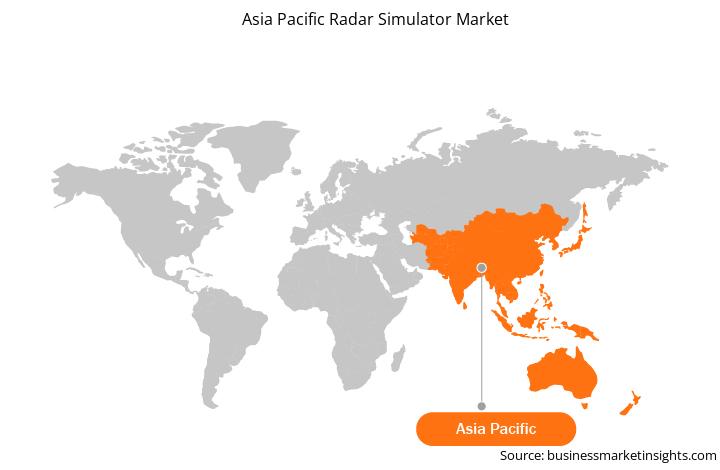The adoption of artificial intelligence (AI), deep learning, and big data analytics is continuously increasing across various applications in the military & defense sector, making AI increasingly important for developing modern warfare systems. Unmanned aerial vehicles (UAVs) developed by various enterprises have modern capabilities and have extended their reach and operating boundaries. There has been a surge in the development of laser-guided missiles with higher accuracy to hit the locked target. To combat this threat in the future, there would be a rise in the development of radars and radar simulators to train operators to combat the rising modern warfare systems. Edge Computing, AI, and machine learning are expected to speed up the development and adoption of AI-enabled warfare systems, which is anticipated to boost the radar simulator market growth in the coming years. Machine learning and deep learning have increased the computing power of drones, making them smarter and faster. Furthermore, edge computing integrated with AI has enabled military and defense enterprises to detect faults in their warfare systems and proactively avoid unplanned downtime. Additionally, the implementation of 5G is expected to enable massive device connectivity, which increases the capabilities of modern warfare systems due to reducing latency while using AI technology. Thus, the growing development of modern warfare systems is expected to positively impact the growth of the radar simulator market during the forecast period.
Strategic insights for the Asia Pacific Radar Simulator provides data-driven analysis of the industry landscape, including current trends, key players, and regional nuances. These insights offer actionable recommendations, enabling readers to differentiate themselves from competitors by identifying untapped segments or developing unique value propositions. Leveraging data analytics, these insights help industry players anticipate the market shifts, whether investors, manufacturers, or other stakeholders. A future-oriented perspective is essential, helping stakeholders anticipate market shifts and position themselves for long-term success in this dynamic region. Ultimately, effective strategic insights empower readers to make informed decisions that drive profitability and achieve their business objectives within the market.

| Report Attribute | Details |
|---|---|
| Market size in 2022 | US$ 326.19 Million |
| Market Size by 2028 | US$ 470.54 Million |
| Global CAGR (2022 - 2028) | 6.3% |
| Historical Data | 2020-2021 |
| Forecast period | 2023-2028 |
| Segments Covered |
By Component
|
| Regions and Countries Covered | Asia-Pacific
|
| Market leaders and key company profiles |
The geographic scope of the Asia Pacific Radar Simulator refers to the specific areas in which a business operates and competes. Understanding local distinctions, such as diverse consumer preferences (e.g., demand for specific plug types or battery backup durations), varying economic conditions, and regulatory environments, is crucial for tailoring strategies to specific markets. Businesses can expand their reach by identifying underserved areas or adapting their offerings to meet local demands. A clear market focus allows for more effective resource allocation, targeted marketing campaigns, and better positioning against local competitors, ultimately driving growth in those targeted areas.

The Asia Pacific radar simulator market is segmented based on component, system, application, and country. Based on component, the market has been segmented into hardware and software. The hardware segment would dominate the Asia Pacific radar simulator market in 2022. In terms of system, the market is divided into system testing and operator training. The operator training segment would dominate the Asia Pacific radar simulator market in 2022. Based on application, the market has been bifurcated into military and commercial. The commercial segment dominated the Asia Pacific radar simulator market in 2022. Based on country, The Asia Pacific radar simulator market is segmented into Australia, China, India, Japan, South Korea, and the Rest of Asia Pacific. China would dominate the market in 2022.
Key players operating in the Asia Pacific radar simulator market include Adacel Technologies Limited; ARI Simulation; Collins Aerospace; L3Harris Technologies, Inc.; Mercury Systems Inc.; Micro Nav Limited; Textron Systems Corporation; and Ultra Electronics Inc.
The Asia Pacific Radar Simulator Market is valued at US$ 326.19 Million in 2022, it is projected to reach US$ 470.54 Million by 2028.
As per our report Asia Pacific Radar Simulator Market, the market size is valued at US$ 326.19 Million in 2022, projecting it to reach US$ 470.54 Million by 2028. This translates to a CAGR of approximately 6.3% during the forecast period.
The Asia Pacific Radar Simulator Market report typically cover these key segments-
The historic period, base year, and forecast period can vary slightly depending on the specific market research report. However, for the Asia Pacific Radar Simulator Market report:
The Asia Pacific Radar Simulator Market is populated by several key players, each contributing to its growth and innovation. Some of the major players include:
The Asia Pacific Radar Simulator Market report is valuable for diverse stakeholders, including:
Essentially, anyone involved in or considering involvement in the Asia Pacific Radar Simulator Market value chain can benefit from the information contained in a comprehensive market report.